University of Bolton: MBA 7013 Strategic Management Analysis Report
VerifiedAdded on 2021/07/28
|29
|7345
|405
Report
AI Summary
This report provides a comprehensive strategic analysis of Radic8, an air purification company. It begins with an overview of the company's context, its partnership with INBair, and the importance of strategy. The report then delves into a critical evaluation of strategic management tools, specifically Porter's Five Forces and the Balance Scorecard. The application of these tools to Radic8's business is explored, followed by recommendations for the company's strategic development. The report also examines the relevance of strategy as practice (SAP) in informing organizational strategy, including its concepts of practitioners, praxis, and practices. The analysis covers competitive advantage, the challenges of developing and deploying strategy, and a reflective assessment of the learning outcomes. The report utilizes figures and tables to present the data, analysis, and recommendations for Radic8.
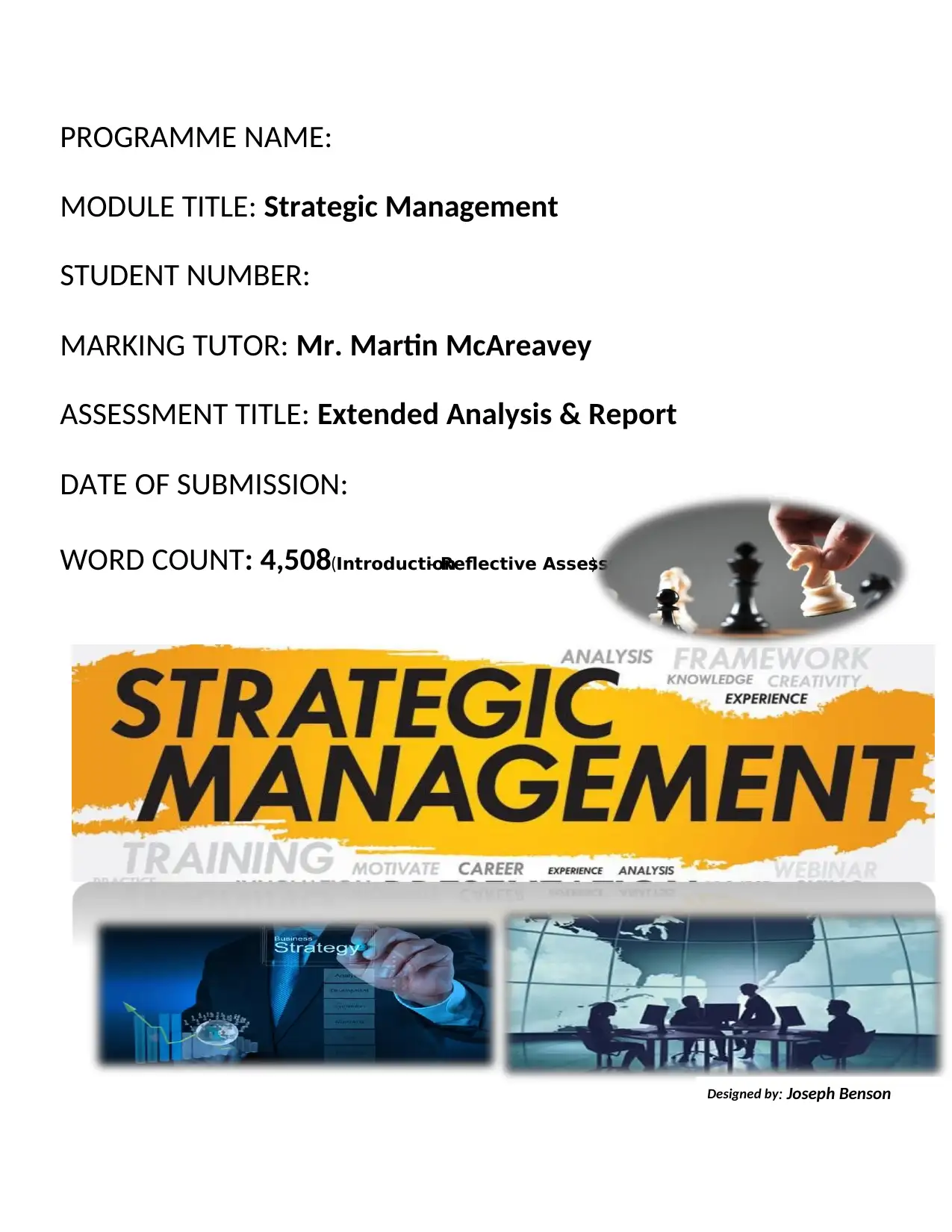
PROGRAMME NAME:
MODULE TITLE: Strategic Management
STUDENT NUMBER:
MARKING TUTOR: Mr. Martin McAreavey
ASSESSMENT TITLE: Extended Analysis & Report
DATE OF SUBMISSION:
WORD COUNT: 4,508(Introduction– Reflective Assessment)
Designed by: Joseph Benson
MODULE TITLE: Strategic Management
STUDENT NUMBER:
MARKING TUTOR: Mr. Martin McAreavey
ASSESSMENT TITLE: Extended Analysis & Report
DATE OF SUBMISSION:
WORD COUNT: 4,508(Introduction– Reflective Assessment)
Designed by: Joseph Benson
Paraphrase This Document
Need a fresh take? Get an instant paraphrase of this document with our AI Paraphraser
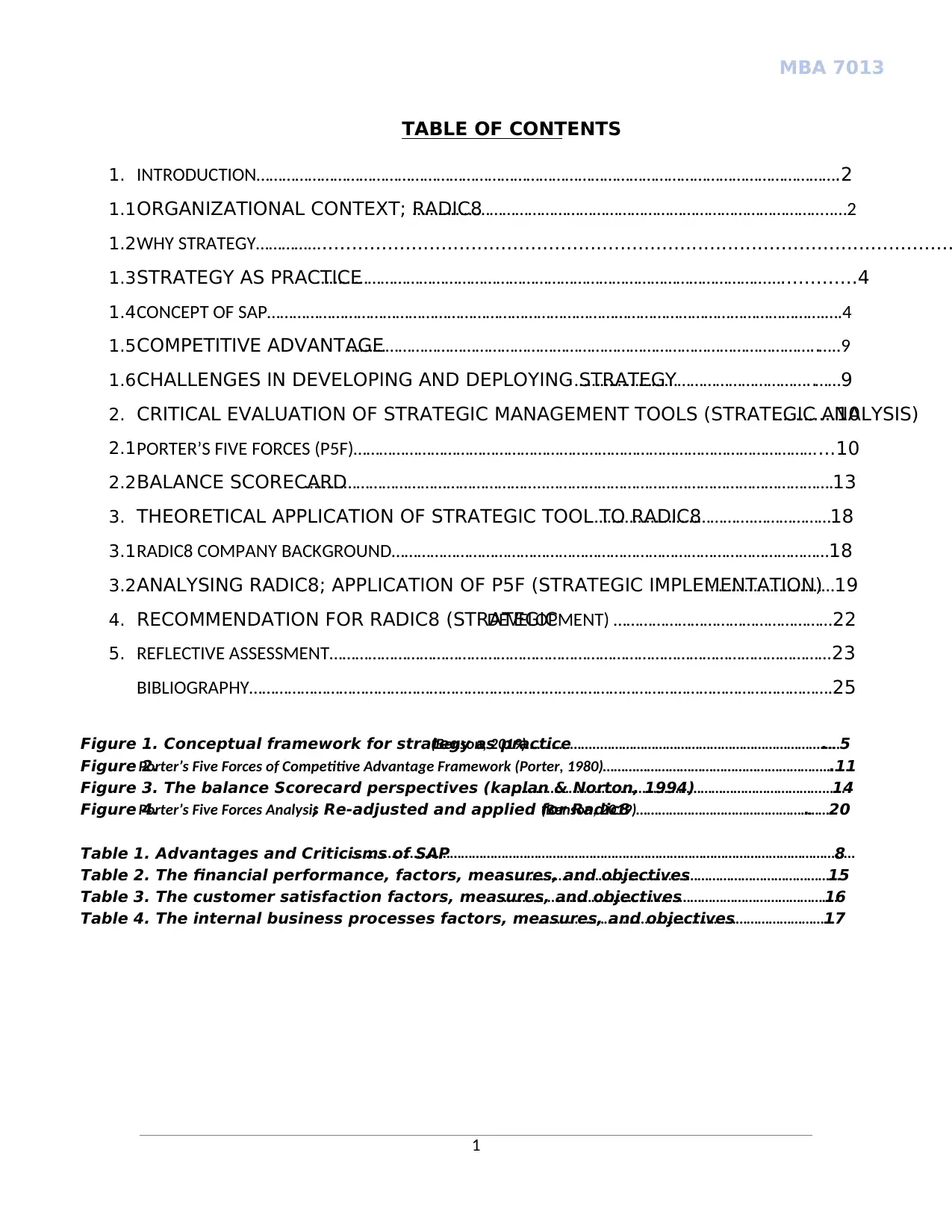
MBA 7013
1
TABLE OF CONTENTS
1. INTRODUCTION……………………………………………………………………………………………………………………….2
1.1ORGANIZATIONAL CONTEXT; RADIC8……………………………………………………………………………………..…2
1.2WHY STRATEGY………….............................................................................................................
1.3STRATEGY AS PRACTICE……………………………………………………………………………………………................4
1.4CONCEPT OF SAP………………………………………………………………………………………………………………….….4
1.5COMPETITIVE ADVANTAGE………………………………………………………………………………………………..…..9
1.6CHALLENGES IN DEVELOPING AND DEPLOYING STRATEGY………………………………………………..……9
2. CRITICAL EVALUATION OF STRATEGIC MANAGEMENT TOOLS (STRATEGIC ANALYSIS)………....10
2.1PORTER’S FIVE FORCES (P5F)………………………………………………………………………………………………...10
2.2BALANCE SCORECARD………………………………………………..………………………………………………………….13
3. THEORETICAL APPLICATION OF STRATEGIC TOOL TO RADIC8……………………………….………………18
3.1RADIC8 COMPANY BACKGROUND…………………………………………………………………………………………18
3.2ANALYSING RADIC8; APPLICATION OF P5F (STRATEGIC IMPLEMENTATION)…………………………19
4. RECOMMENDATION FOR RADIC8 (STRATEGICDEVELOPMENT) ……………………………………………22
5. REFLECTIVE ASSESSMENT………………………………………………………………………………………………………23
BIBLIOGRAPHY……………………………………………………………………………………………………………………….25
Figure 1. Conceptual framework for strategy as practice(Benson, 2019)………………..…………………………………………………….….….5
Figure 2.Porter’s Five Forces of Competitive Advantage Framework (Porter, 1980)…………………………………………………….……..11
Figure 3. The balance Scorecard perspectives (kaplan & Norton, 1994)………………………………………………………………………….…..14
Figure 4.Porter’s Five Forces Analysis; Re-adjusted and applied for Radic8(Benson, 2019)………………………………………….……20
Table 1. Advantages and Criticisms of SAP………………………………………………………………………………………………………………………..…8
Table 2. The financial performance, factors, measures, and objectives………………………………………………………………………………15
Table 3. The customer satisfaction factors, measures, and objectives……………………………………………………………………………….16
Table 4. The internal business processes factors, measures, and objectives………………………………………………………………………17
1
TABLE OF CONTENTS
1. INTRODUCTION……………………………………………………………………………………………………………………….2
1.1ORGANIZATIONAL CONTEXT; RADIC8……………………………………………………………………………………..…2
1.2WHY STRATEGY………….............................................................................................................
1.3STRATEGY AS PRACTICE……………………………………………………………………………………………................4
1.4CONCEPT OF SAP………………………………………………………………………………………………………………….….4
1.5COMPETITIVE ADVANTAGE………………………………………………………………………………………………..…..9
1.6CHALLENGES IN DEVELOPING AND DEPLOYING STRATEGY………………………………………………..……9
2. CRITICAL EVALUATION OF STRATEGIC MANAGEMENT TOOLS (STRATEGIC ANALYSIS)………....10
2.1PORTER’S FIVE FORCES (P5F)………………………………………………………………………………………………...10
2.2BALANCE SCORECARD………………………………………………..………………………………………………………….13
3. THEORETICAL APPLICATION OF STRATEGIC TOOL TO RADIC8……………………………….………………18
3.1RADIC8 COMPANY BACKGROUND…………………………………………………………………………………………18
3.2ANALYSING RADIC8; APPLICATION OF P5F (STRATEGIC IMPLEMENTATION)…………………………19
4. RECOMMENDATION FOR RADIC8 (STRATEGICDEVELOPMENT) ……………………………………………22
5. REFLECTIVE ASSESSMENT………………………………………………………………………………………………………23
BIBLIOGRAPHY……………………………………………………………………………………………………………………….25
Figure 1. Conceptual framework for strategy as practice(Benson, 2019)………………..…………………………………………………….….….5
Figure 2.Porter’s Five Forces of Competitive Advantage Framework (Porter, 1980)…………………………………………………….……..11
Figure 3. The balance Scorecard perspectives (kaplan & Norton, 1994)………………………………………………………………………….…..14
Figure 4.Porter’s Five Forces Analysis; Re-adjusted and applied for Radic8(Benson, 2019)………………………………………….……20
Table 1. Advantages and Criticisms of SAP………………………………………………………………………………………………………………………..…8
Table 2. The financial performance, factors, measures, and objectives………………………………………………………………………………15
Table 3. The customer satisfaction factors, measures, and objectives……………………………………………………………………………….16
Table 4. The internal business processes factors, measures, and objectives………………………………………………………………………17
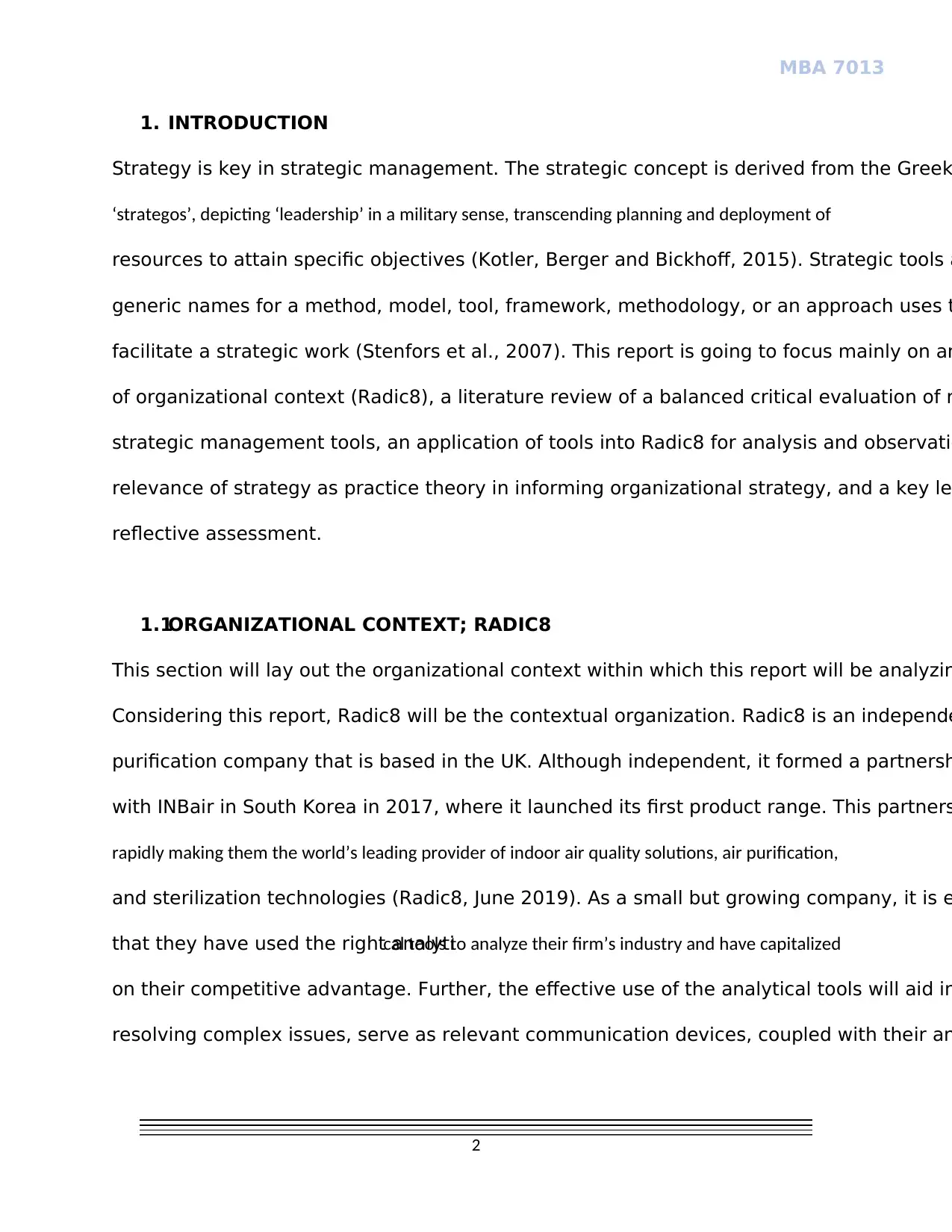
MBA 7013
2
1. INTRODUCTION
Strategy is key in strategic management. The strategic concept is derived from the Greek
‘strategos’, depicting ‘leadership’ in a military sense, transcending planning and deployment of
resources to attain specific objectives (Kotler, Berger and Bickhoff, 2015). Strategic tools a
generic names for a method, model, tool, framework, methodology, or an approach uses t
facilitate a strategic work (Stenfors et al., 2007). This report is going to focus mainly on an
of organizational context (Radic8), a literature review of a balanced critical evaluation of r
strategic management tools, an application of tools into Radic8 for analysis and observatio
relevance of strategy as practice theory in informing organizational strategy, and a key le
reflective assessment.
1.1ORGANIZATIONAL CONTEXT; RADIC8
This section will lay out the organizational context within which this report will be analyzin
Considering this report, Radic8 will be the contextual organization. Radic8 is an independe
purification company that is based in the UK. Although independent, it formed a partnersh
with INBair in South Korea in 2017, where it launched its first product range. This partners
rapidly making them the world’s leading provider of indoor air quality solutions, air purification,
and sterilization technologies (Radic8, June 2019). As a small but growing company, it is e
that they have used the right analytical tools to analyze their firm’s industry and have capitalized
on their competitive advantage. Further, the effective use of the analytical tools will aid in
resolving complex issues, serve as relevant communication devices, coupled with their an
2
1. INTRODUCTION
Strategy is key in strategic management. The strategic concept is derived from the Greek
‘strategos’, depicting ‘leadership’ in a military sense, transcending planning and deployment of
resources to attain specific objectives (Kotler, Berger and Bickhoff, 2015). Strategic tools a
generic names for a method, model, tool, framework, methodology, or an approach uses t
facilitate a strategic work (Stenfors et al., 2007). This report is going to focus mainly on an
of organizational context (Radic8), a literature review of a balanced critical evaluation of r
strategic management tools, an application of tools into Radic8 for analysis and observatio
relevance of strategy as practice theory in informing organizational strategy, and a key le
reflective assessment.
1.1ORGANIZATIONAL CONTEXT; RADIC8
This section will lay out the organizational context within which this report will be analyzin
Considering this report, Radic8 will be the contextual organization. Radic8 is an independe
purification company that is based in the UK. Although independent, it formed a partnersh
with INBair in South Korea in 2017, where it launched its first product range. This partners
rapidly making them the world’s leading provider of indoor air quality solutions, air purification,
and sterilization technologies (Radic8, June 2019). As a small but growing company, it is e
that they have used the right analytical tools to analyze their firm’s industry and have capitalized
on their competitive advantage. Further, the effective use of the analytical tools will aid in
resolving complex issues, serve as relevant communication devices, coupled with their an
⊘ This is a preview!⊘
Do you want full access?
Subscribe today to unlock all pages.

Trusted by 1+ million students worldwide
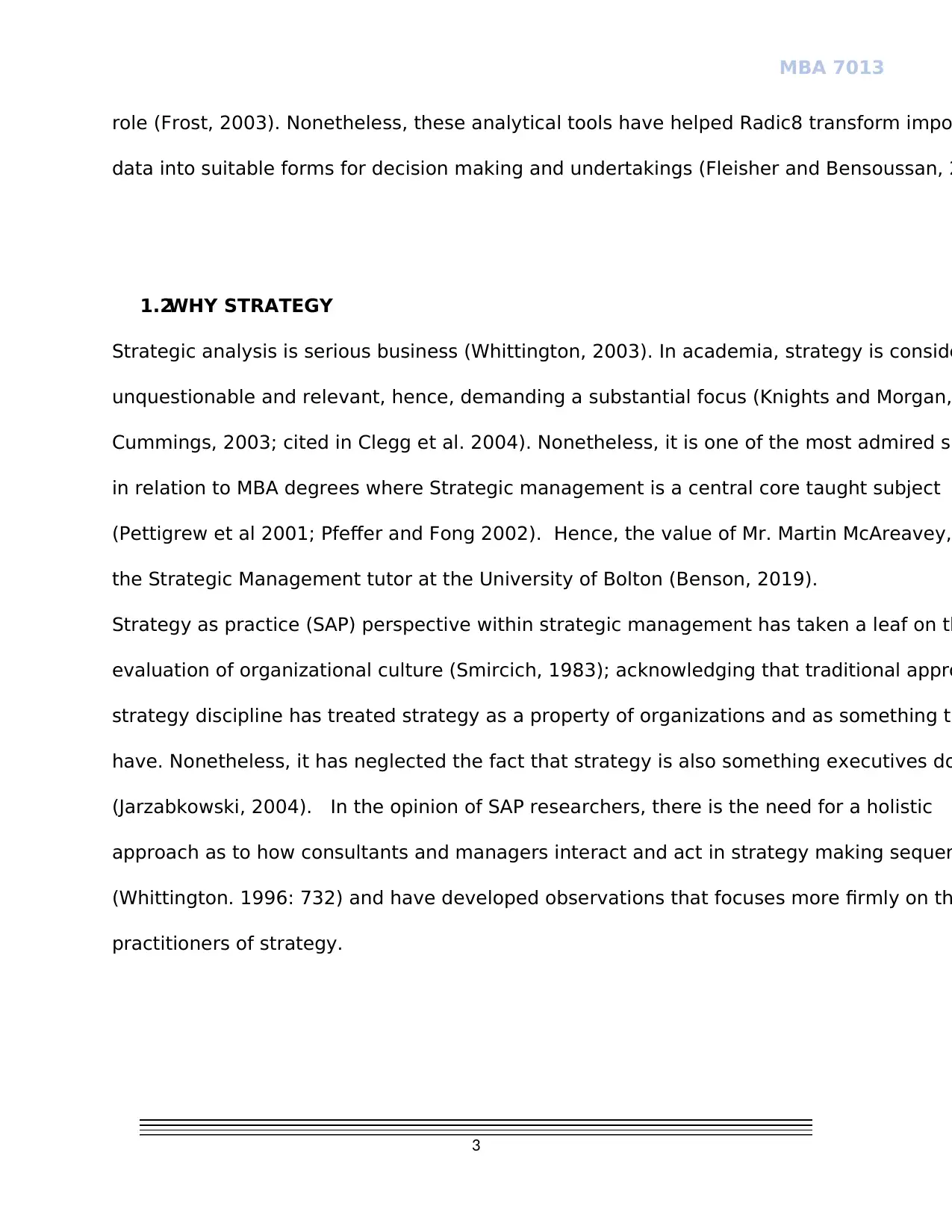
MBA 7013
3
role (Frost, 2003). Nonetheless, these analytical tools have helped Radic8 transform impo
data into suitable forms for decision making and undertakings (Fleisher and Bensoussan, 2
1.2WHY STRATEGY
Strategic analysis is serious business (Whittington, 2003). In academia, strategy is conside
unquestionable and relevant, hence, demanding a substantial focus (Knights and Morgan,
Cummings, 2003; cited in Clegg et al. 2004). Nonetheless, it is one of the most admired su
in relation to MBA degrees where Strategic management is a central core taught subject
(Pettigrew et al 2001; Pfeffer and Fong 2002). Hence, the value of Mr. Martin McAreavey,
the Strategic Management tutor at the University of Bolton (Benson, 2019).
Strategy as practice (SAP) perspective within strategic management has taken a leaf on th
evaluation of organizational culture (Smircich, 1983); acknowledging that traditional appro
strategy discipline has treated strategy as a property of organizations and as something th
have. Nonetheless, it has neglected the fact that strategy is also something executives do
(Jarzabkowski, 2004). In the opinion of SAP researchers, there is the need for a holistic
approach as to how consultants and managers interact and act in strategy making sequen
(Whittington. 1996: 732) and have developed observations that focuses more firmly on th
practitioners of strategy.
3
role (Frost, 2003). Nonetheless, these analytical tools have helped Radic8 transform impo
data into suitable forms for decision making and undertakings (Fleisher and Bensoussan, 2
1.2WHY STRATEGY
Strategic analysis is serious business (Whittington, 2003). In academia, strategy is conside
unquestionable and relevant, hence, demanding a substantial focus (Knights and Morgan,
Cummings, 2003; cited in Clegg et al. 2004). Nonetheless, it is one of the most admired su
in relation to MBA degrees where Strategic management is a central core taught subject
(Pettigrew et al 2001; Pfeffer and Fong 2002). Hence, the value of Mr. Martin McAreavey,
the Strategic Management tutor at the University of Bolton (Benson, 2019).
Strategy as practice (SAP) perspective within strategic management has taken a leaf on th
evaluation of organizational culture (Smircich, 1983); acknowledging that traditional appro
strategy discipline has treated strategy as a property of organizations and as something th
have. Nonetheless, it has neglected the fact that strategy is also something executives do
(Jarzabkowski, 2004). In the opinion of SAP researchers, there is the need for a holistic
approach as to how consultants and managers interact and act in strategy making sequen
(Whittington. 1996: 732) and have developed observations that focuses more firmly on th
practitioners of strategy.
Paraphrase This Document
Need a fresh take? Get an instant paraphrase of this document with our AI Paraphraser
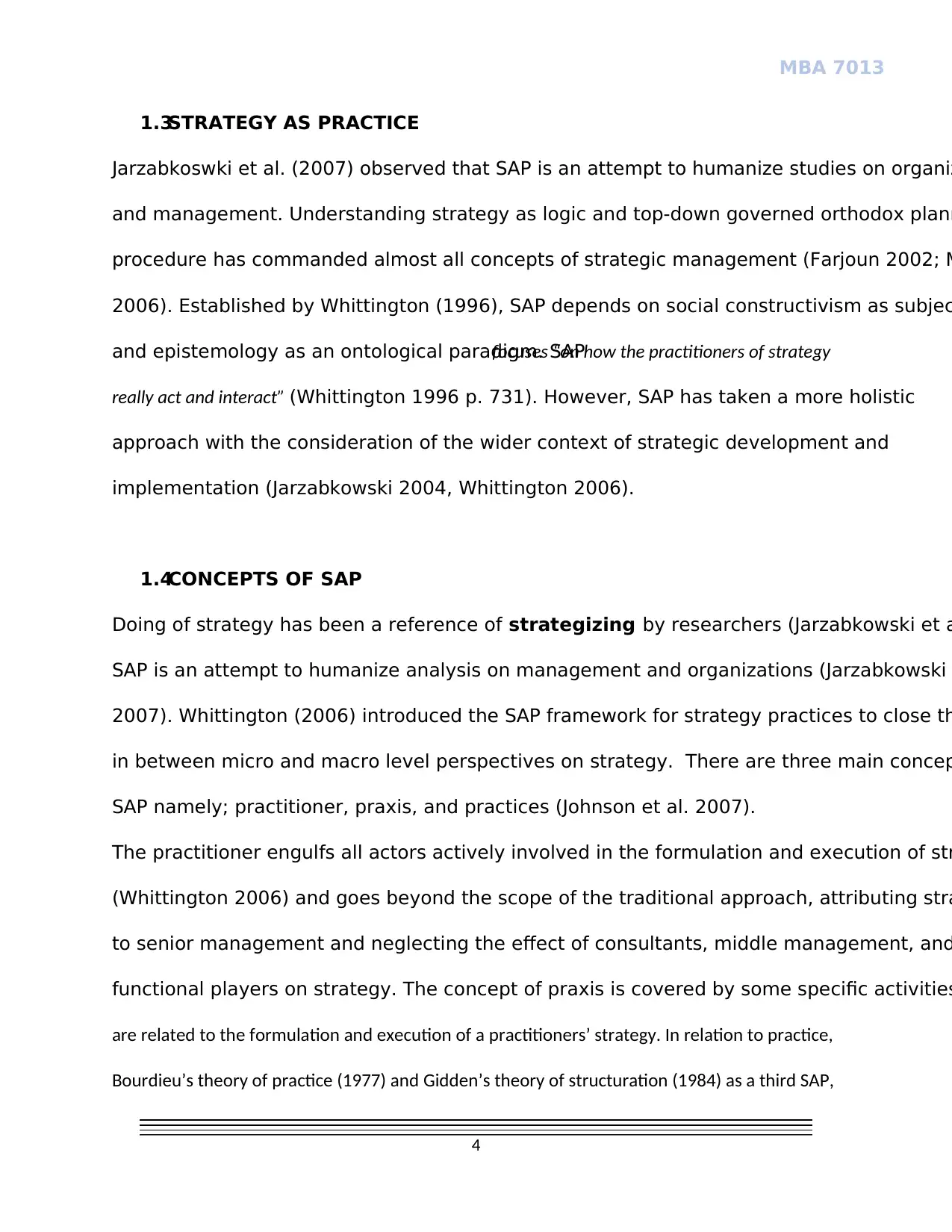
MBA 7013
4
1.3STRATEGY AS PRACTICE
Jarzabkoswki et al. (2007) observed that SAP is an attempt to humanize studies on organiz
and management. Understanding strategy as logic and top-down governed orthodox plann
procedure has commanded almost all concepts of strategic management (Farjoun 2002; M
2006). Established by Whittington (1996), SAP depends on social constructivism as subjec
and epistemology as an ontological paradigm. SAPfocuses “on how the practitioners of strategy
really act and interact” (Whittington 1996 p. 731). However, SAP has taken a more holistic
approach with the consideration of the wider context of strategic development and
implementation (Jarzabkowski 2004, Whittington 2006).
1.4CONCEPTS OF SAP
Doing of strategy has been a reference of strategizing by researchers (Jarzabkowski et a
SAP is an attempt to humanize analysis on management and organizations (Jarzabkowski
2007). Whittington (2006) introduced the SAP framework for strategy practices to close th
in between micro and macro level perspectives on strategy. There are three main concep
SAP namely; practitioner, praxis, and practices (Johnson et al. 2007).
The practitioner engulfs all actors actively involved in the formulation and execution of str
(Whittington 2006) and goes beyond the scope of the traditional approach, attributing stra
to senior management and neglecting the effect of consultants, middle management, and
functional players on strategy. The concept of praxis is covered by some specific activities
are related to the formulation and execution of a practitioners’ strategy. In relation to practice,
Bourdieu’s theory of practice (1977) and Gidden’s theory of structuration (1984) as a third SAP,
4
1.3STRATEGY AS PRACTICE
Jarzabkoswki et al. (2007) observed that SAP is an attempt to humanize studies on organiz
and management. Understanding strategy as logic and top-down governed orthodox plann
procedure has commanded almost all concepts of strategic management (Farjoun 2002; M
2006). Established by Whittington (1996), SAP depends on social constructivism as subjec
and epistemology as an ontological paradigm. SAPfocuses “on how the practitioners of strategy
really act and interact” (Whittington 1996 p. 731). However, SAP has taken a more holistic
approach with the consideration of the wider context of strategic development and
implementation (Jarzabkowski 2004, Whittington 2006).
1.4CONCEPTS OF SAP
Doing of strategy has been a reference of strategizing by researchers (Jarzabkowski et a
SAP is an attempt to humanize analysis on management and organizations (Jarzabkowski
2007). Whittington (2006) introduced the SAP framework for strategy practices to close th
in between micro and macro level perspectives on strategy. There are three main concep
SAP namely; practitioner, praxis, and practices (Johnson et al. 2007).
The practitioner engulfs all actors actively involved in the formulation and execution of str
(Whittington 2006) and goes beyond the scope of the traditional approach, attributing stra
to senior management and neglecting the effect of consultants, middle management, and
functional players on strategy. The concept of praxis is covered by some specific activities
are related to the formulation and execution of a practitioners’ strategy. In relation to practice,
Bourdieu’s theory of practice (1977) and Gidden’s theory of structuration (1984) as a third SAP,
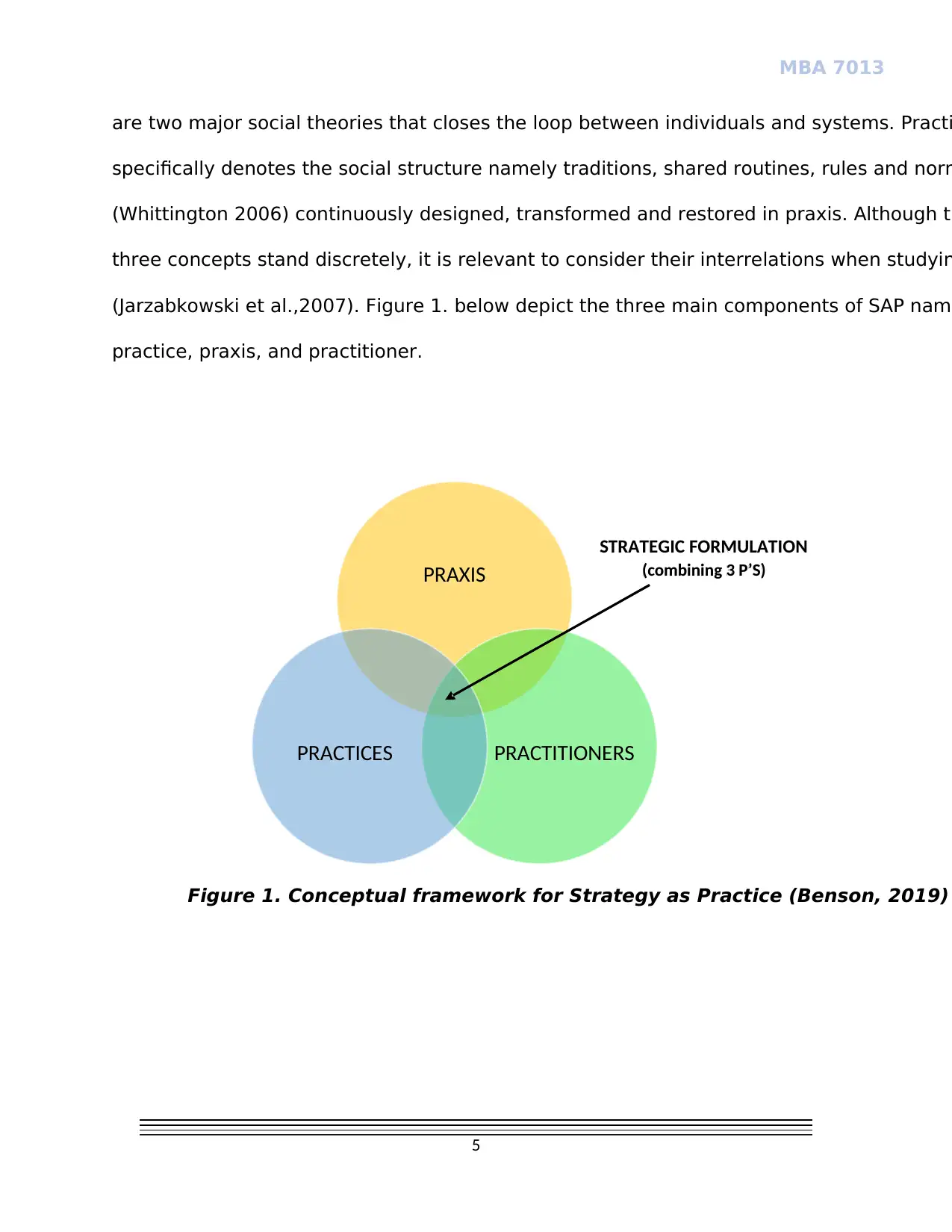
MBA 7013
5
are two major social theories that closes the loop between individuals and systems. Practi
specifically denotes the social structure namely traditions, shared routines, rules and norm
(Whittington 2006) continuously designed, transformed and restored in praxis. Although th
three concepts stand discretely, it is relevant to consider their interrelations when studyin
(Jarzabkowski et al.,2007). Figure 1. below depict the three main components of SAP name
practice, praxis, and practitioner.
PRAXIS
PRACTITIONERSPRACTICES
Figure 1. Conceptual framework for Strategy as Practice (Benson, 2019)
STRATEGIC FORMULATION
(combining 3 P’S)
5
are two major social theories that closes the loop between individuals and systems. Practi
specifically denotes the social structure namely traditions, shared routines, rules and norm
(Whittington 2006) continuously designed, transformed and restored in praxis. Although th
three concepts stand discretely, it is relevant to consider their interrelations when studyin
(Jarzabkowski et al.,2007). Figure 1. below depict the three main components of SAP name
practice, praxis, and practitioner.
PRAXIS
PRACTITIONERSPRACTICES
Figure 1. Conceptual framework for Strategy as Practice (Benson, 2019)
STRATEGIC FORMULATION
(combining 3 P’S)
⊘ This is a preview!⊘
Do you want full access?
Subscribe today to unlock all pages.

Trusted by 1+ million students worldwide
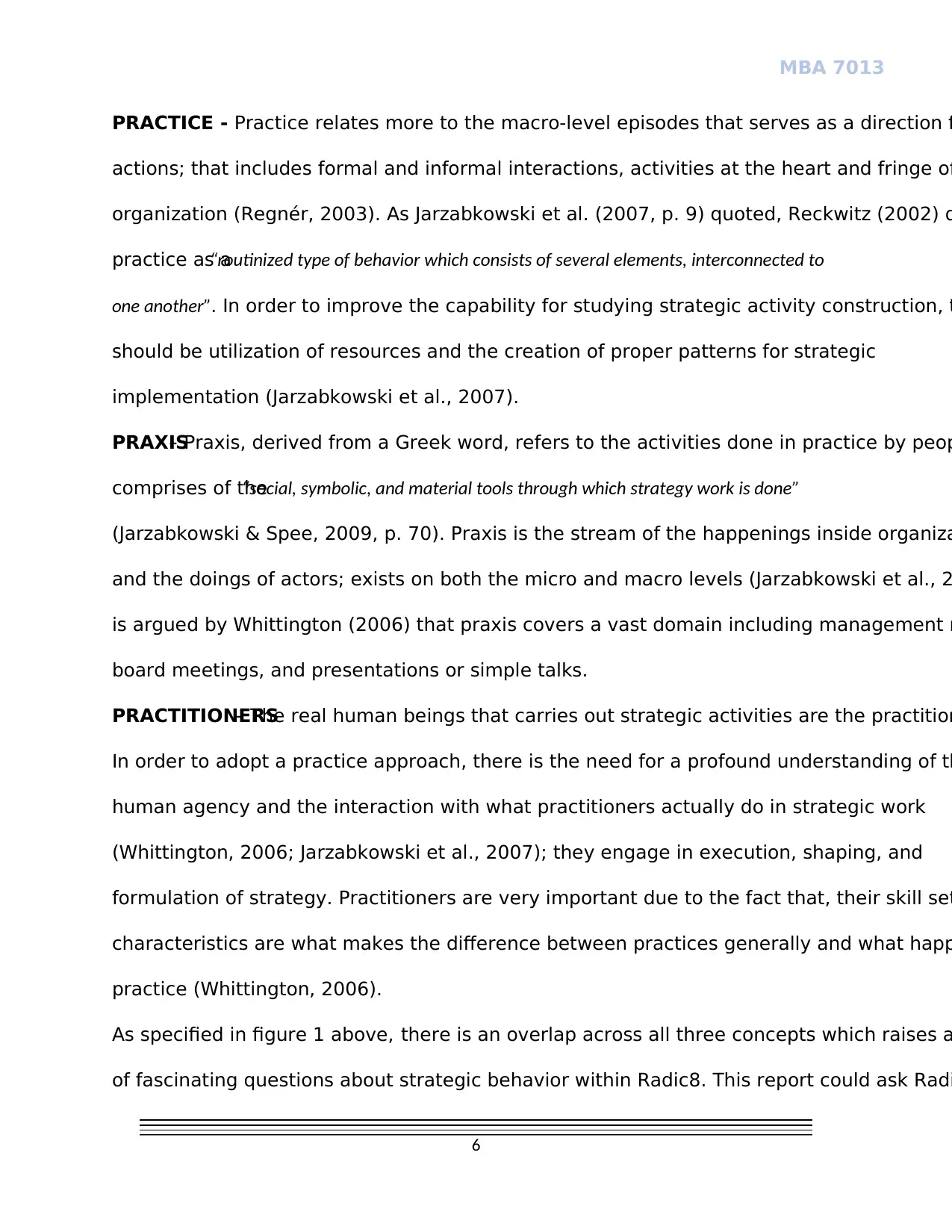
MBA 7013
6
PRACTICE - Practice relates more to the macro-level episodes that serves as a direction f
actions; that includes formal and informal interactions, activities at the heart and fringe of
organization (Regnér, 2003). As Jarzabkowski et al. (2007, p. 9) quoted, Reckwitz (2002) d
practice as a“routinized type of behavior which consists of several elements, interconnected to
one another”. In order to improve the capability for studying strategic activity construction, t
should be utilization of resources and the creation of proper patterns for strategic
implementation (Jarzabkowski et al., 2007).
PRAXIS– Praxis, derived from a Greek word, refers to the activities done in practice by peop
comprises of the“social, symbolic, and material tools through which strategy work is done”
(Jarzabkowski & Spee, 2009, p. 70). Praxis is the stream of the happenings inside organiza
and the doings of actors; exists on both the micro and macro levels (Jarzabkowski et al., 2
is argued by Whittington (2006) that praxis covers a vast domain including management r
board meetings, and presentations or simple talks.
PRACTITIONERS– The real human beings that carries out strategic activities are the practition
In order to adopt a practice approach, there is the need for a profound understanding of th
human agency and the interaction with what practitioners actually do in strategic work
(Whittington, 2006; Jarzabkowski et al., 2007); they engage in execution, shaping, and
formulation of strategy. Practitioners are very important due to the fact that, their skill set
characteristics are what makes the difference between practices generally and what happ
practice (Whittington, 2006).
As specified in figure 1 above, there is an overlap across all three concepts which raises a
of fascinating questions about strategic behavior within Radic8. This report could ask Radi
6
PRACTICE - Practice relates more to the macro-level episodes that serves as a direction f
actions; that includes formal and informal interactions, activities at the heart and fringe of
organization (Regnér, 2003). As Jarzabkowski et al. (2007, p. 9) quoted, Reckwitz (2002) d
practice as a“routinized type of behavior which consists of several elements, interconnected to
one another”. In order to improve the capability for studying strategic activity construction, t
should be utilization of resources and the creation of proper patterns for strategic
implementation (Jarzabkowski et al., 2007).
PRAXIS– Praxis, derived from a Greek word, refers to the activities done in practice by peop
comprises of the“social, symbolic, and material tools through which strategy work is done”
(Jarzabkowski & Spee, 2009, p. 70). Praxis is the stream of the happenings inside organiza
and the doings of actors; exists on both the micro and macro levels (Jarzabkowski et al., 2
is argued by Whittington (2006) that praxis covers a vast domain including management r
board meetings, and presentations or simple talks.
PRACTITIONERS– The real human beings that carries out strategic activities are the practition
In order to adopt a practice approach, there is the need for a profound understanding of th
human agency and the interaction with what practitioners actually do in strategic work
(Whittington, 2006; Jarzabkowski et al., 2007); they engage in execution, shaping, and
formulation of strategy. Practitioners are very important due to the fact that, their skill set
characteristics are what makes the difference between practices generally and what happ
practice (Whittington, 2006).
As specified in figure 1 above, there is an overlap across all three concepts which raises a
of fascinating questions about strategic behavior within Radic8. This report could ask Radi
Paraphrase This Document
Need a fresh take? Get an instant paraphrase of this document with our AI Paraphraser
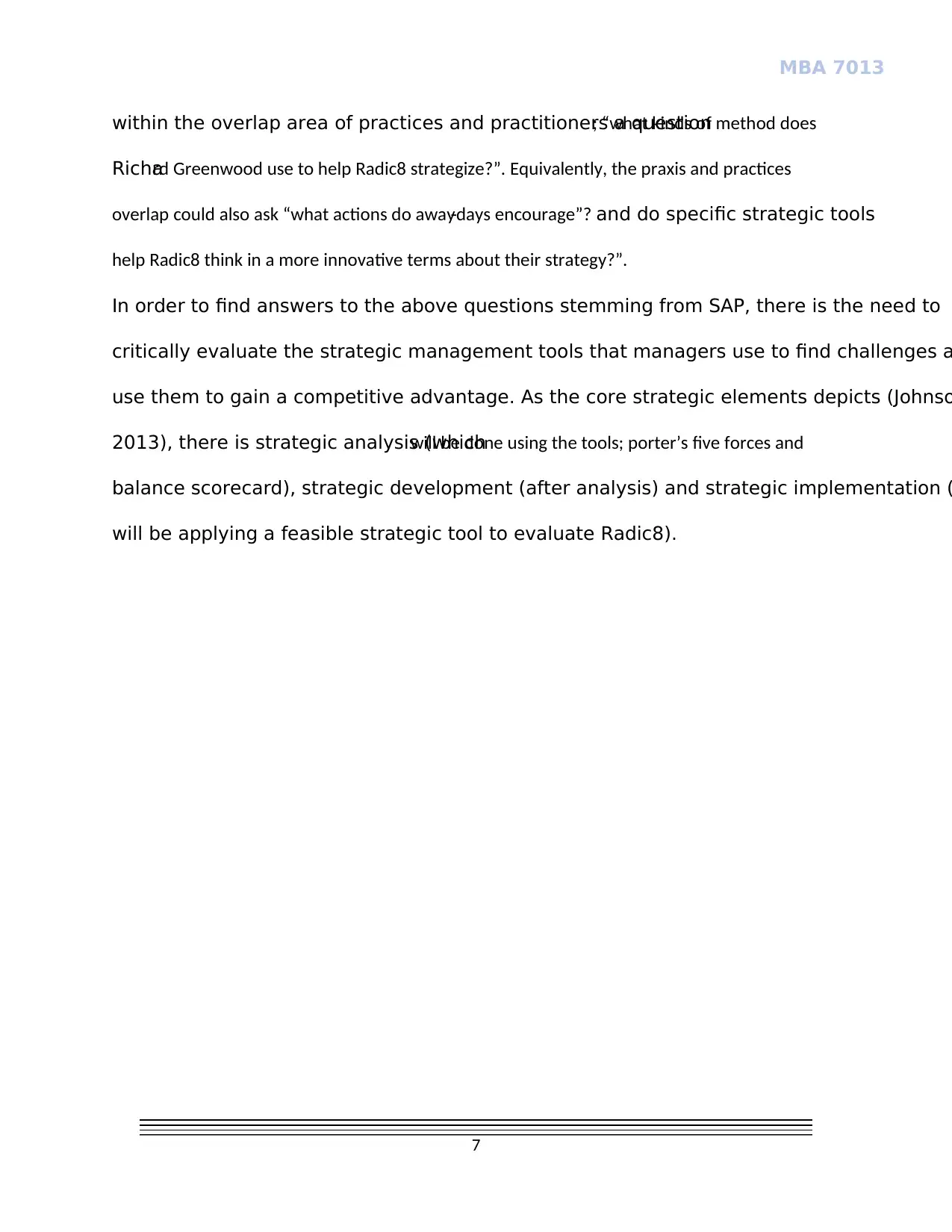
MBA 7013
7
within the overlap area of practices and practitioners a question; “what kinds of method does
Richard Greenwood use to help Radic8 strategize?”. Equivalently, the praxis and practices
overlap could also ask “what actions do away-days encourage”? and do specific strategic tools
help Radic8 think in a more innovative terms about their strategy?”.
In order to find answers to the above questions stemming from SAP, there is the need to
critically evaluate the strategic management tools that managers use to find challenges a
use them to gain a competitive advantage. As the core strategic elements depicts (Johnso
2013), there is strategic analysis (whichwill be done using the tools; porter’s five forces and
balance scorecard), strategic development (after analysis) and strategic implementation (
will be applying a feasible strategic tool to evaluate Radic8).
7
within the overlap area of practices and practitioners a question; “what kinds of method does
Richard Greenwood use to help Radic8 strategize?”. Equivalently, the praxis and practices
overlap could also ask “what actions do away-days encourage”? and do specific strategic tools
help Radic8 think in a more innovative terms about their strategy?”.
In order to find answers to the above questions stemming from SAP, there is the need to
critically evaluate the strategic management tools that managers use to find challenges a
use them to gain a competitive advantage. As the core strategic elements depicts (Johnso
2013), there is strategic analysis (whichwill be done using the tools; porter’s five forces and
balance scorecard), strategic development (after analysis) and strategic implementation (
will be applying a feasible strategic tool to evaluate Radic8).
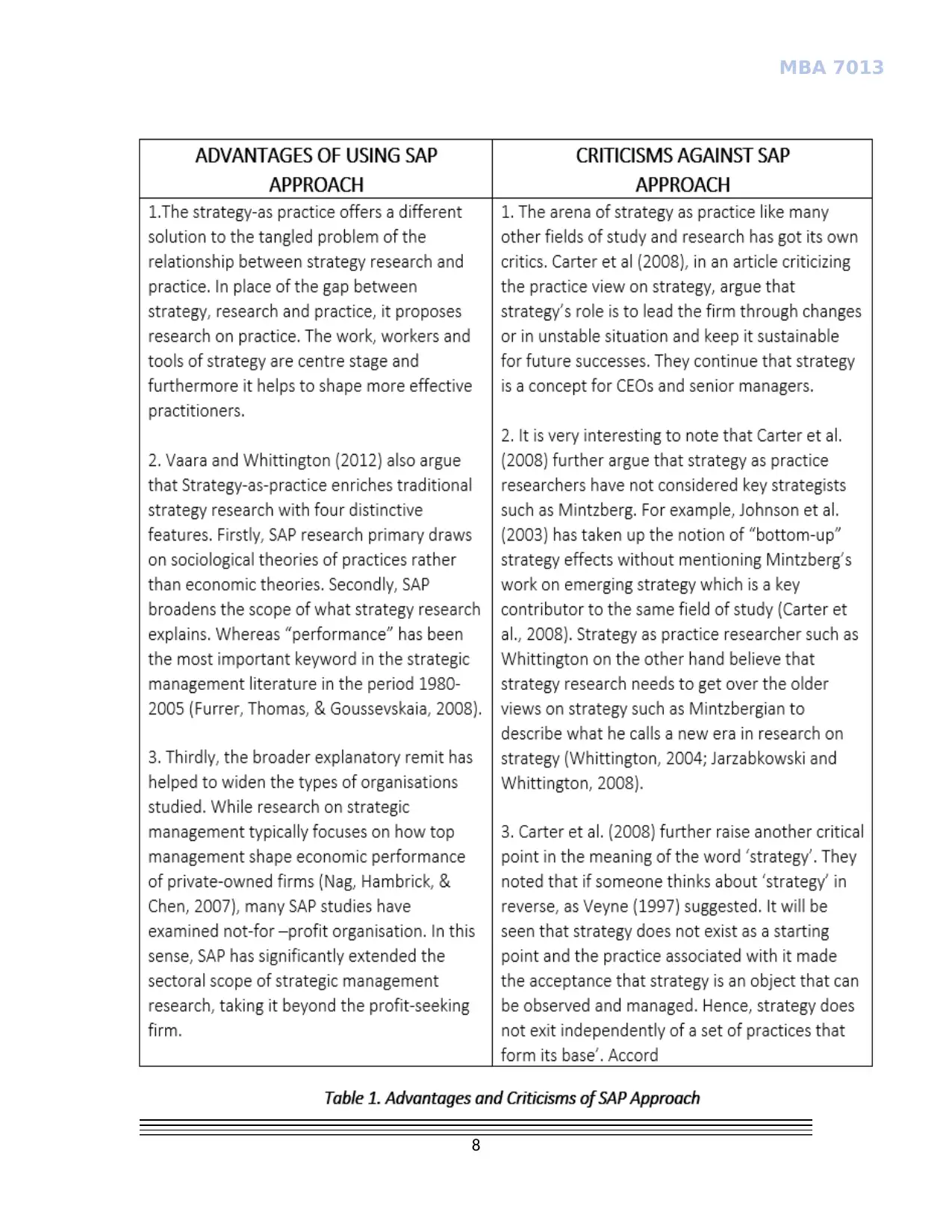
MBA 7013
8
8
⊘ This is a preview!⊘
Do you want full access?
Subscribe today to unlock all pages.

Trusted by 1+ million students worldwide
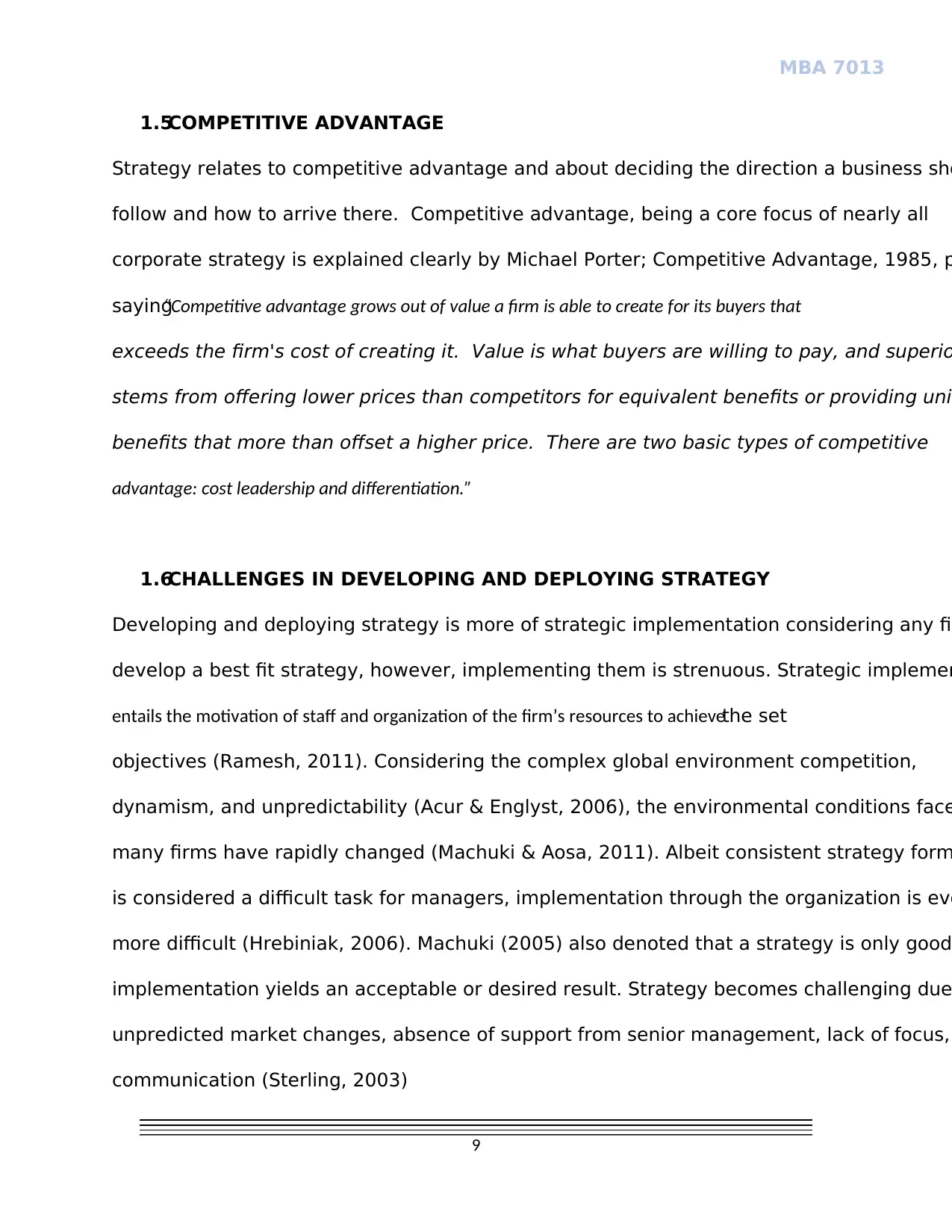
MBA 7013
9
1.5COMPETITIVE ADVANTAGE
Strategy relates to competitive advantage and about deciding the direction a business sho
follow and how to arrive there. Competitive advantage, being a core focus of nearly all
corporate strategy is explained clearly by Michael Porter; Competitive Advantage, 1985, p
saying“Competitive advantage grows out of value a firm is able to create for its buyers that
exceeds the firm's cost of creating it. Value is what buyers are willing to pay, and superio
stems from offering lower prices than competitors for equivalent benefits or providing uniq
benefits that more than offset a higher price. There are two basic types of competitive
advantage: cost leadership and differentiation.”
1.6CHALLENGES IN DEVELOPING AND DEPLOYING STRATEGY
Developing and deploying strategy is more of strategic implementation considering any fir
develop a best fit strategy, however, implementing them is strenuous. Strategic implemen
entails the motivation of staff and organization of the firm’s resources to achievethe set
objectives (Ramesh, 2011). Considering the complex global environment competition,
dynamism, and unpredictability (Acur & Englyst, 2006), the environmental conditions face
many firms have rapidly changed (Machuki & Aosa, 2011). Albeit consistent strategy form
is considered a difficult task for managers, implementation through the organization is eve
more difficult (Hrebiniak, 2006). Machuki (2005) also denoted that a strategy is only good
implementation yields an acceptable or desired result. Strategy becomes challenging due
unpredicted market changes, absence of support from senior management, lack of focus,
communication (Sterling, 2003)
9
1.5COMPETITIVE ADVANTAGE
Strategy relates to competitive advantage and about deciding the direction a business sho
follow and how to arrive there. Competitive advantage, being a core focus of nearly all
corporate strategy is explained clearly by Michael Porter; Competitive Advantage, 1985, p
saying“Competitive advantage grows out of value a firm is able to create for its buyers that
exceeds the firm's cost of creating it. Value is what buyers are willing to pay, and superio
stems from offering lower prices than competitors for equivalent benefits or providing uniq
benefits that more than offset a higher price. There are two basic types of competitive
advantage: cost leadership and differentiation.”
1.6CHALLENGES IN DEVELOPING AND DEPLOYING STRATEGY
Developing and deploying strategy is more of strategic implementation considering any fir
develop a best fit strategy, however, implementing them is strenuous. Strategic implemen
entails the motivation of staff and organization of the firm’s resources to achievethe set
objectives (Ramesh, 2011). Considering the complex global environment competition,
dynamism, and unpredictability (Acur & Englyst, 2006), the environmental conditions face
many firms have rapidly changed (Machuki & Aosa, 2011). Albeit consistent strategy form
is considered a difficult task for managers, implementation through the organization is eve
more difficult (Hrebiniak, 2006). Machuki (2005) also denoted that a strategy is only good
implementation yields an acceptable or desired result. Strategy becomes challenging due
unpredicted market changes, absence of support from senior management, lack of focus,
communication (Sterling, 2003)
Paraphrase This Document
Need a fresh take? Get an instant paraphrase of this document with our AI Paraphraser
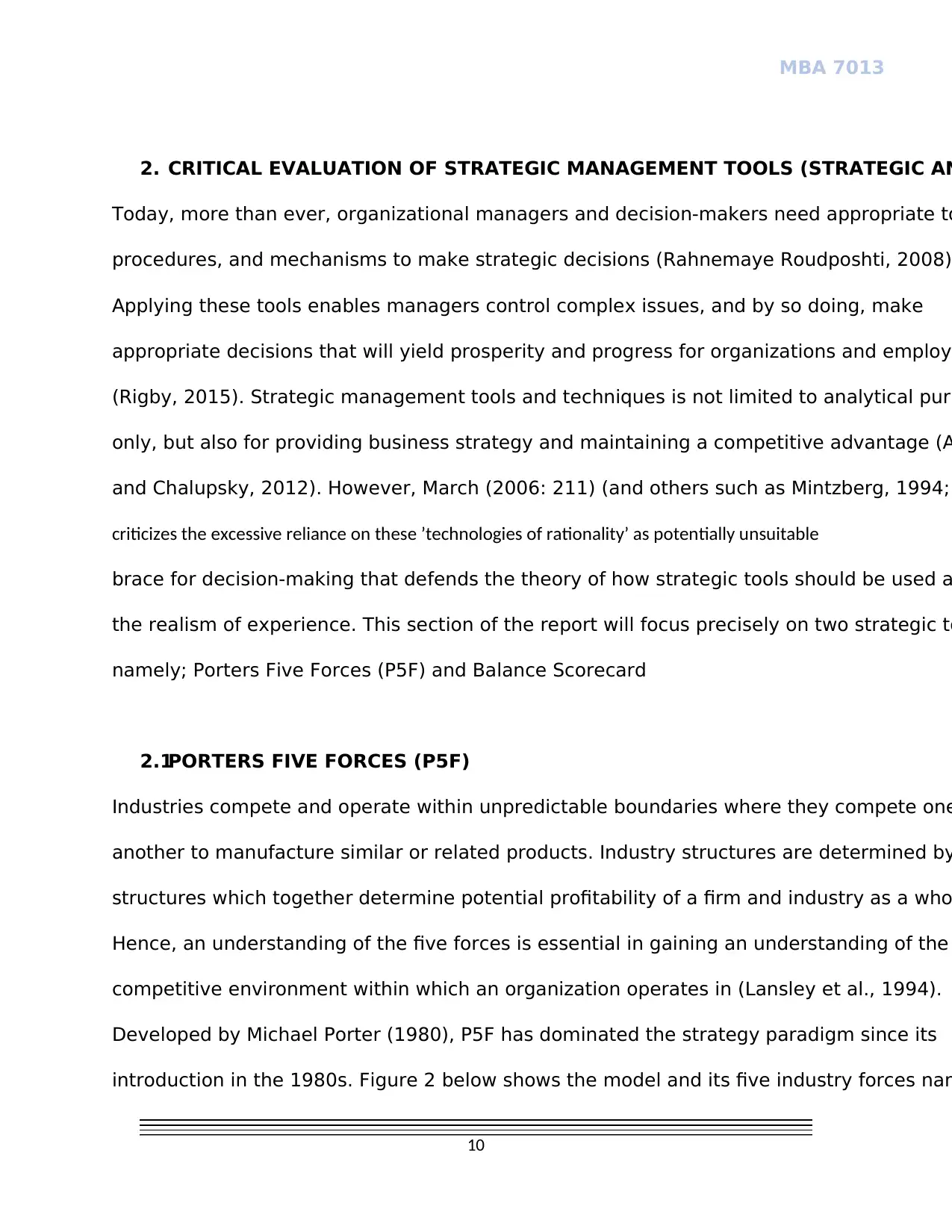
MBA 7013
10
2. CRITICAL EVALUATION OF STRATEGIC MANAGEMENT TOOLS (STRATEGIC AN
Today, more than ever, organizational managers and decision-makers need appropriate to
procedures, and mechanisms to make strategic decisions (Rahnemaye Roudposhti, 2008)
Applying these tools enables managers control complex issues, and by so doing, make
appropriate decisions that will yield prosperity and progress for organizations and employe
(Rigby, 2015). Strategic management tools and techniques is not limited to analytical purp
only, but also for providing business strategy and maintaining a competitive advantage (A
and Chalupsky, 2012). However, March (2006: 211) (and others such as Mintzberg, 1994;
criticizes the excessive reliance on these ’technologies of rationality’ as potentially unsuitable
brace for decision-making that defends the theory of how strategic tools should be used a
the realism of experience. This section of the report will focus precisely on two strategic to
namely; Porters Five Forces (P5F) and Balance Scorecard
2.1PORTERS FIVE FORCES (P5F)
Industries compete and operate within unpredictable boundaries where they compete one
another to manufacture similar or related products. Industry structures are determined by
structures which together determine potential profitability of a firm and industry as a who
Hence, an understanding of the five forces is essential in gaining an understanding of the
competitive environment within which an organization operates in (Lansley et al., 1994).
Developed by Michael Porter (1980), P5F has dominated the strategy paradigm since its
introduction in the 1980s. Figure 2 below shows the model and its five industry forces nam
10
2. CRITICAL EVALUATION OF STRATEGIC MANAGEMENT TOOLS (STRATEGIC AN
Today, more than ever, organizational managers and decision-makers need appropriate to
procedures, and mechanisms to make strategic decisions (Rahnemaye Roudposhti, 2008)
Applying these tools enables managers control complex issues, and by so doing, make
appropriate decisions that will yield prosperity and progress for organizations and employe
(Rigby, 2015). Strategic management tools and techniques is not limited to analytical purp
only, but also for providing business strategy and maintaining a competitive advantage (A
and Chalupsky, 2012). However, March (2006: 211) (and others such as Mintzberg, 1994;
criticizes the excessive reliance on these ’technologies of rationality’ as potentially unsuitable
brace for decision-making that defends the theory of how strategic tools should be used a
the realism of experience. This section of the report will focus precisely on two strategic to
namely; Porters Five Forces (P5F) and Balance Scorecard
2.1PORTERS FIVE FORCES (P5F)
Industries compete and operate within unpredictable boundaries where they compete one
another to manufacture similar or related products. Industry structures are determined by
structures which together determine potential profitability of a firm and industry as a who
Hence, an understanding of the five forces is essential in gaining an understanding of the
competitive environment within which an organization operates in (Lansley et al., 1994).
Developed by Michael Porter (1980), P5F has dominated the strategy paradigm since its
introduction in the 1980s. Figure 2 below shows the model and its five industry forces nam
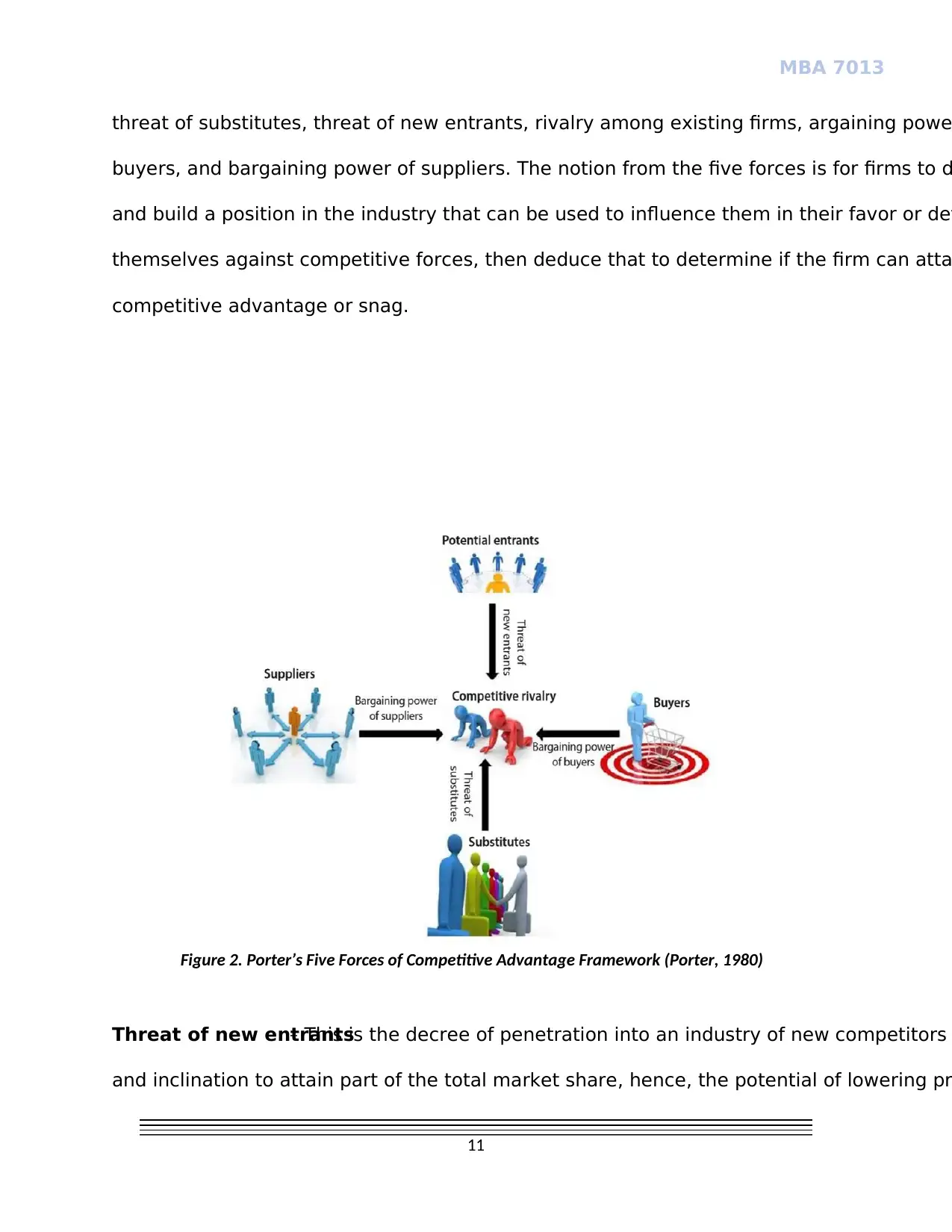
MBA 7013
11
threat of substitutes, threat of new entrants, rivalry among existing firms, argaining powe
buyers, and bargaining power of suppliers. The notion from the five forces is for firms to d
and build a position in the industry that can be used to influence them in their favor or def
themselves against competitive forces, then deduce that to determine if the firm can atta
competitive advantage or snag.
Threat of new entrants– This is the decree of penetration into an industry of new competitors
and inclination to attain part of the total market share, hence, the potential of lowering pr
Figure 2. Porter’s Five Forces of Competitive Advantage Framework (Porter, 1980)
11
threat of substitutes, threat of new entrants, rivalry among existing firms, argaining powe
buyers, and bargaining power of suppliers. The notion from the five forces is for firms to d
and build a position in the industry that can be used to influence them in their favor or def
themselves against competitive forces, then deduce that to determine if the firm can atta
competitive advantage or snag.
Threat of new entrants– This is the decree of penetration into an industry of new competitors
and inclination to attain part of the total market share, hence, the potential of lowering pr
Figure 2. Porter’s Five Forces of Competitive Advantage Framework (Porter, 1980)
⊘ This is a preview!⊘
Do you want full access?
Subscribe today to unlock all pages.

Trusted by 1+ million students worldwide
1 out of 29
Related Documents
Your All-in-One AI-Powered Toolkit for Academic Success.
+13062052269
info@desklib.com
Available 24*7 on WhatsApp / Email
![[object Object]](/_next/static/media/star-bottom.7253800d.svg)
Unlock your academic potential
Copyright © 2020–2025 A2Z Services. All Rights Reserved. Developed and managed by ZUCOL.





